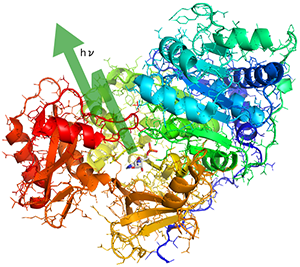Summary of BioHiKR
 Light emitting organisms have been attracted us from the ancient time.
Based on the literature search in 2018, organisms in 117 different families belonging to 12 different phyla are known to emit light.
These organisms are luminous and are not fluorescent, hence have an organ for light generation.
In this organ, a chemical reaction taken place on a small molecule called luciferin, is catalysed by an enzyme named luciferase or photoprotein.
The amino acid sequences and protein structures of luciferases and photoproteins from different organisms are mostly different, so that luminescent mechanisms should have evolved independently.
The idea of independent and convergent evolution of the luciferase and photoprotein is further supported by the scattered distribution of light emitting species over the phylogenetic tree of life.
Light emitting organisms have been attracted us from the ancient time.
Based on the literature search in 2018, organisms in 117 different families belonging to 12 different phyla are known to emit light.
These organisms are luminous and are not fluorescent, hence have an organ for light generation.
In this organ, a chemical reaction taken place on a small molecule called luciferin, is catalysed by an enzyme named luciferase or photoprotein.
The amino acid sequences and protein structures of luciferases and photoproteins from different organisms are mostly different, so that luminescent mechanisms should have evolved independently.
The idea of independent and convergent evolution of the luciferase and photoprotein is further supported by the scattered distribution of light emitting species over the phylogenetic tree of life.
BioHiKR aims to collect data of bioluminescence, including species, habitats, organelles, proteins, ligands and chemical reactions.
So far, out of 117 families, the habitat of 103 families (88%) were found in ocean, of 13 families were on land (11%) and of only one family was in freshwater (1%).
The light emitting mechanism of each organism can be divided into two.
One is by utilising proteins encoded in its own genome, and the other is by the proteins encoded in the genome of symbiotic bacterium.
The proteins can be classified into ten groups, based on their sequence similarity.
Luciferin, the light emitting ligand, can be classified into nine groups, based on their backbone structures.
BioHiKR aims to be used for evolutionary analyses as well as for a platform for the modification of luciferase/photoprotein for a marker material of wetlab experiments.
 Light emitting organisms have been attracted us from the ancient time.
Based on the literature search in 2018, organisms in 117 different families belonging to 12 different phyla are known to emit light.
These organisms are luminous and are not fluorescent, hence have an organ for light generation.
In this organ, a chemical reaction taken place on a small molecule called luciferin, is catalysed by an enzyme named luciferase or photoprotein.
The amino acid sequences and protein structures of luciferases and photoproteins from different organisms are mostly different, so that luminescent mechanisms should have evolved independently.
The idea of independent and convergent evolution of the luciferase and photoprotein is further supported by the scattered distribution of light emitting species over the phylogenetic tree of life.
Light emitting organisms have been attracted us from the ancient time.
Based on the literature search in 2018, organisms in 117 different families belonging to 12 different phyla are known to emit light.
These organisms are luminous and are not fluorescent, hence have an organ for light generation.
In this organ, a chemical reaction taken place on a small molecule called luciferin, is catalysed by an enzyme named luciferase or photoprotein.
The amino acid sequences and protein structures of luciferases and photoproteins from different organisms are mostly different, so that luminescent mechanisms should have evolved independently.
The idea of independent and convergent evolution of the luciferase and photoprotein is further supported by the scattered distribution of light emitting species over the phylogenetic tree of life.